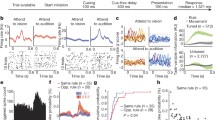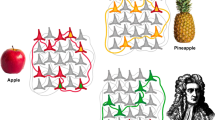Abstract
This chapter presents the first comprehensive high-level theory of the information processing function of mammalian cortex and thalamus; herein viewed as a unary structure. The theory consists of four major elements: two novel associative memory neuronal network structures (feature attractor networks and antecedent support networks), a universal information processing operation (consensus building), and an overall real-time brain control system (the brain command loop). One important derived type of thalamocortical neural network is also presented, the hierarchical abstractor (which, as with all other networks of thalamocortex, is “constructed” out of antecedent support and feature attractor networks). Some smaller constructs are also introduced. Arguments are presented as to why this theory must be basically correct. READER WARNING: The content of this chapter is complicated and almost entirely novel and unfamiliar. Detailed study and multiple readings may be required. Effort expended in learning its content will be richly rewarded. Carrying out computer experiments can be a useful learning adjunct. For simplicity and readability, the theory is presented as fact, without constant recitation of disclaimers such as “it is hypothesized.”
Access this chapter
Tax calculation will be finalised at checkout
Purchases are for personal use only
Preview
Unable to display preview. Download preview PDF.
Similar content being viewed by others
References
Abeles, M. (1991) Corticonics. Cambridge, UK: Cambridge Univ. Press.
Amari, S. (1989) Characteristics of sparsely encoded associative memory. Neural Networks 2: 451–457.
Amari, S. (1974) A method of statistical neurodynamics. Biological Cybernetics 14: 201–215.
Amari, S. (1972) Learning patterns and pattern sequences by self-organizing nets of threshold elements. IEEE Trans. Comput. C-21: 1197–1206.
Anderson, J.A. (1968) A memory storage model utilizing spatial correlation functions. Kybernetik 5: 113–119.
Anderson, J.A. (1972) A simple neural network generating an interactive memory. Mathematical Biosciences 14: 197–220.
Anderson, J.A., Silverstein, J.W., Ritz, S.A., Jones, R.S. (1977) Distinctive features, categorical perception, and probability learning: Some applications of a neural model. Psych. Rev. 84: 413–451.
Bender, E.A. (1996) Mathematical Methods in Artificial Intelligence. Los Alamitos, CA: IEEE Computer Society Press.
Bennett, C.H., Gacs, P., Li, M., Vitanyi, P.M.B., Zurek, W.H. (1998) Information distance. IEEE Trans. Infor. Th. 44: 1407–1423.
Borisyuk, R., Borisyuk, G., Kazanovich, Y. (1998) Synchronization of neural activity and information processing. Behavioral and Brain Sciences 21: 833–844.
Braitenberg V., Schuz, A. (1998) Cortex: Statistics and Geometry of Neuronal Connectivity, Second Edition. Berlin: Springer-Verlag.
Carpenter, G.A., Grossberg, S. (Eds.) (1991) Pattern Recognition by Self-Organizing Neural Networks. Cambridge, MA: MIT Press.
Carpenter, G.A., Grossberg, S. (1988) Adaptive Resonance. In: Grossberg, S. (Ed.) Neural Networks and Natural Intelligence. Cambridge, MA: MIT Press, 251–315.
Chover, J. (1996) Neural correlation via random connections. Neural Computation 8:1711–1729.
Cohen, M.A., Grossberg, S. (1983) Absolute stability of global pattern formation and parallel memory storage by competitive neural networks. IEEE Trans. Sys. Man and Cyber. 13: 815–826.
Cowan, W.M., Sudhof, T.C., Stevens, C.F. (Eds.) (2001) Synapses. Baltimore, MD: Johns Hopkins Univ. Press.
Crick, F.H.C. (1984) Function of the thalamic reticular complex: The searchlight hypothesis. Proc. Nat. Acad. Sci. 81: 4586–4590.
Fain, G.L. (1999) Molecular and Cellular Physiology of Neurons. Cambridge, MA: Harvard Univ. Press.
Fries, P., Reynolds, J.H., Rorie, A.E., Desimone, R. (2001) Modulation of oscillatory neuronal synchronization by selective visual attention. Science 291: 1560–1563.
Fukushima, K. (1975) Cognitron: A self-organizing multilayered neural network. Biological Cybernetics 20: 121–136.
Fukushima, K., Miyake, S. (1978) A self-organizing neural network with a function of associative memory: Feedback-type Cognitron. Biological Cybernetics 28: 201–208.
Gerstein, G.L. (2001) Neural assemblies: Technical issues, analysis, and modeling. Neural Networks 14: 589–598.
Grossberg, S., Williamson, J.R. (2001) A neural model of how horizontal and interlaminar connections of visual cortex develop into adult circuits that carry out perceptual groupings and learning. Cerebral Cortex 11: 37–58.
Grossberg, S. (1999) How does the cerebral cortex work? Learning, attention and grouping by the laminar circuits of visual cortex. Spatial Vision 12: 163–186.
Grossberg, S., Mingolla, E., Ross, W.D. (1997) Visual brain and visual perception: How does the cortex do perceptual grouping? Trends in Neurosciences 20: 106–111.
Grossberg, S. (1997) Cortical dynamics of three-dimensional figure-ground perception of two-dimensional patterns. Psych. Rev. 104: 618–658.
Grossberg, S. (1995) The attentive brain. American Scientist 83: 438–449.
Grossberg, S. (Ed.) (1987) The Adaptive Brain, Volumes I and II. Amsterdam: Elsevier.
Grossberg, S. (Ed.) (1982) Studies of Mind and Brain. Norwell, MA: Kluwer.
Grossberg, S. (1976) Adaptive pattern classification and universal recoding. Biological Cybernetics 23: 121–134.
Grossberg, S. (1968) Some nonlinear networks capable of learning a spatial pattern of arbitrary complexity. Proceedings of the National Academy of Sciences 59: 368–372.
Haines, K., Hecht-Nielsen, R. (1988) A BAM with increase information storage capacity. Proceedings, 1988 International Conf. on Neural Networks, Piscataway NJ: IEEE Press, I-181-I-190.
Hall, Z.W. (1992) Molecular Neurobiology. Sunderland, MA: Sinauer.
Hebb, D. (1949) The Organization of Behavior. New York: Wiley.
Herculano-Houzel, S., Munk, M.H.J., Neuenschwander, S., Singer, W. (1999) Precisely synchronized oscillatory firing patterns require electroencephalographic activation. J. Neurosci. 19: 3992–4010.
Hopfield, J.J. (1982) Neural networks and physical systems with emergent collective computational abilities. Proc. Natl. Acad. Sci. 79: 2554–2558.
Izhikevich, E.M. (2001) Resonate-and-fire neurons. Neural Networks 14: 883–894.
Jones, E.G. (1985) The Thalamus. New York: Plenum Press.
Kainen, P.C, Kůrková, V. (1993) On quasiorthogonal dimension of euclidean space. Applied Math Lett. 6: 7–10.
Koch, C, Crick, F.H.C. (1994) Some further ideas regarding the neuronal basis of awareness, In: Koch, C., Davis, J. (Eds.) Large-Scale Neuronal Theories of the Brain. Cambridge, MA: MIT Press.
Kohonen, T. (1995) Self-Organizing Maps. Berlin: Springer-Verlag.
Kohonen, T. (1984) Self-Organization and Associative Memory. Berlin: Springer-Verlag.
Kohonen, T. (1972) Correlation matrix memories. IEEE Transactions on Computers C2l: 353–359.
Konig, P., Engel, A.K., Roelfsema, P.R., Singer, W. (1995) How precise is neuronal synchronization. Neural Computation 7: 469–485.
Kosko, B. (1988) Bidirectional associative memories. IEEE Trans. On Systems, Man, and Cybernetics SMC-18, 49–60.
Kryukov, V.I., Borisyuk, G.N., Borisyuk, R.M., Kirillov, A.B., Kovalenko, E.I. (1990) Metastable and unstable states in the brain. In: R.L. Dobrushin, V.I. Kryukov, A.L. Toom (Eds.) Stochastic Cellular Systems. Manchester, UK: Manchester Univ. Press.
Ledoux, M. (2001) The Concentration of Measure Phenomenon. Providence, RI: American Mathematical Society.
Miller, G. A. (1996) The Science of Words. New York: Scientific American Library.
Mountcastle, V.B. (1998) Perceptual Neuroscience: The Cerebral Cortex. Cambridge, MA: Harvard Univ. Press.
Nakano, K. (1972) Associatron - a model of associative memory. IEEE Transactions on Systems, Man, and Cybernetics SMC-2: 380–388.
Nicholls, J.G, Martin, A.R., Wallace, B.G, Fuchs, P.A. (2001) From Neuron to Brain, Fourth Edition. Sunderland, MA: Sinauer.
Nicolelis, M.A.L., Baccala, L.A., Lin, R.C., Chapin, J.K. (1995) Sensorimotor encoding by synchronous neural ensemble activity at multiple levels of the somatosensory system. Science 268: 1353–1358.
Nilsson, N.J. (1998) Artificial Intelligence: A New Synthesis. San Francisco: Morgan Freeman Publishers.
Nilsson, N.J. (1965) Learning Machines. New York: McGraw-Hill.
Nolte, J. (1999) The Human Brain, Fourth Edition. St. Louis, MO: Mosby.
Oja, E. (1980) On the convergence of an associative learning algorithm in the presence of noise. International Journal of Systems Science 11: 629–640.
Palm, G. (1980) On associative memory. Biol. Cybern. 36: 19–31.
Sagi, B., Nemat-Nasser, S.C., Kerr, R., Hayek, R., Downing, C., Hecht-Nielsen, R. (2001) A biologically motivated solution to the cocktail party problem. Neural Computation 13: 1575–1602.
Schneider, W.X., Owen, A.M., Duncan, J. (Eds.) (2000) Executive Control and the Frontal Lobe. Berlin: Springer-Verlag.
Sejnowski, T.J., Destexhe, A. (2000) Why do we sleep? Brain Research 886: 208–223.
Sherman, S.M., Guillery, R.W. (2001) Exploring the Thalamus. San Diego, CA: Academic Press.
Shin, J. (2001) Adaptation in spiking neurons based on the noise shaping neural coding hypothesis. Neural Networks 14: 907–919.
Sommer, F.T., Palm, G. (1999) Improved bidirectional retrieval of sparse patterns stored by Hebbian learning. Neural Networks 12: 281–297.
Steinbuch, K. (1961a) Automat und Mensch. Heidelberg: Springer-Verlag.
Steinbuch, K. (1963) Automat und Mensch, Second Edition. Heidelberg: Springer-Verlag.
Steinbuch, K. (1965) Automat und Mensch, Third Edition. Heidelberg: Springer-Verlag.
Steinbuch, K. (1961b) Die lernmatrix. Kybernetik 1: 36–45.
Steinbuch, K., Piske, U.A.W. (1963) Learning matrices and their applications. IEEE Transactions on Electronic Computers December: 846–862.
Steinbuch, K., Widrow, B. (1965) A critical comparison of two kinds of adaptive classification networks. IEEE Transactions on Electronic Computers October:737–740.
Steward, O. (2000) Functional Neuroscience. New York: Springer-Verlag.
Stryker, M.P. (2001) Drums keep pounding a rhythm in the brain. Science 291: 1506–1507.
Thorpe, S., Delorme, A., Van Rullen, R. (2001) Spike-based strategies for rapid processing. Neural Networks 14: 715–725.
Ukhtomsky, A.A. (1966) Dominanta (in Russian). Leningrad: USSR Academy of Sciences.
von der Malsburg, C. (1981) The correlation theory of brain function. Internal Report 81–2, Max-Planck-Inst. for Biophysical Chemistry.
Widrow, B., Hoff, M.E. (1960) Adaptive switching circuits. 1960 IRE WESCON Convention Record, New York: Institute of Radio Engineers, 96–104.
Willshaw, D.J., Buneman, O.P., Longuet-Higgins, H.C. (1969) Non-holographic associative memory. Nature 222: 960–962.
Zadeh, L.A. (1965) Fuzzy sets. Information and Control, 8, 338–353.
Zador, P. (1963) Development and Evaluation of Procedures for Quantizing Multivariate Distributions, PhD Dissertation, Palo Alto, CA: Stanford University.
Editor information
Editors and Affiliations
Rights and permissions
Copyright information
© 2003 Springer-Verlag London Limited
About this chapter
Cite this chapter
Hecht-Nielsen, R. (2003). A Theory of Thalamocortex. In: Hecht-Nielsen, R., McKenna, T. (eds) Computational Models for Neuroscience. Springer, London. https://doi.org/10.1007/978-1-4471-0085-0_4
Download citation
DOI: https://doi.org/10.1007/978-1-4471-0085-0_4
Publisher Name: Springer, London
Print ISBN: 978-1-85233-593-9
Online ISBN: 978-1-4471-0085-0
eBook Packages: Springer Book Archive




